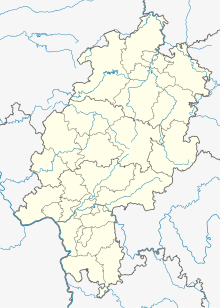Gasterfeld (desert)
Coordinates: 51 ° 19 ′ 49 ″ N , 9 ° 8 ′ 29 ″ E
Gasterfeld was a village, first mentioned in a document in 1074, in what is today the district of the north Hessian city of Wolfhagen , district of Kassel , which was described as desolate in 1406 .
Geographical location
The village was located about 1 km south-southeast of the Philippinendorf settlement founded in 1778 (today Gasterfeld ) at an altitude of 269 m in the valley floor of the Dusebach (formerly also called Dause) on its southern bank, not far east of the Wolfhager Landwehr against the county of Waldeck . Today the federal highway 450 runs from Wolfhagen to Landau about 500 m northeast . The district road 106 from Wolfhagen to Bühle runs about 450 m south. Today an asphalt dirt road crosses the place of the disappeared settlement.
history
The village, called “Gasterveld” in 1074, was the property and ancestral seat of the noble family of the von Gasterfeld family, who presumably owned a bower or a small moated castle there. The first documented member of the family was the nobility of Gasterfeld, mentioned in 1151, who exchanged real estate in Gasterfeld, Nieheim and Langeln with the Hasungen monastery that year . The brothers Heinrich and Eberhard (Eckard) von Gasterfeld built Helfenberg Castle east of Wolfhagen in the first quarter of the 13th century , moved their residence there and the family called themselves "von Helfenberg" from around 1240.
Whether Gasterfeld Castle, which was abandoned by its owners, fell into disrepair, or whether it, like Helfenberg Castle, was defeated by Hessian troops during the armed conflict between Landgrave Heinrich I of Hesse and the Archdiocese of Mainz or during Landgrave Heinrich's campaign against his sovereign claim in 1293 is not known. The village initially remained populated. In 1303 Eckhard V. von Helfenberg sold his third to the village, church fiefdom and forest to Landgrave Heinrich. The other two thirds later came to the Counts of Waldeck. It is not known when the village was completely abandoned. In 1351 a house is mentioned, but although Gasterfeld was still referred to as a village in a document in 1406, it was already desolate at that time. There are no building remains.
The local church , consecrated to the Holy Cross , was on slightly elevated ground in the southwest of the settlement; it was used until the Reformation in the Landgraviate of Hesse in 1526. The ruin existed for another 350 years: in 1850 another vault was broken off, and in 1878 stones from the ruin were used for road construction. In 1919 stones and burned grain were found at the site. Today only the field name "The old church" reminds of the former church.
The lineage of the Lords von Gasterfeld and von Helfenberg became extinct in the male line with Rudolph V. von Helfenberg in 1414. As early as 1409, he had given Landgrave Hermann II of Hesse the reversal of his entire family, not yet otherwise (e.g. to the Aroldessen Monastery ) fiefdom and allodial possessions , including the castle and desert of Gasterfeld, are securitized and the landgrave then moved the place together with the ruined castle as a fallen fiefdom .
New assignment of the place name
The place name Gasterfeld has been in use again since March 1, 1972: as part of the regional reform in Hesse , the two settlements of Philippinendorf (founded in 1778) and Schanze (founded in 1938) to the northwest of the desert were combined under the name Gasterfeld as a district of Wolfhagen.
Footnotes
- ^ Electorate of Hesse 1840-1861 - 13th Wolfhagen. Historical maps. In: Landesgeschichtliches Informationssystem Hessen (LAGIS).
- ↑ The spelling of the place name varied over time: 1074 "Gasterveld / Gasterueld", 1196 "Gastirfeld", 1267 "Gasterfelt", 1290 "Gastervelt / Gasteruelt" and 1367 Gasterfeld ( Gasterfeld (desert), district of Kassel. Historical local dictionary for Hesse . In: Landesgeschichtliches Informationssystem Hessen (LAGIS).).
- ↑ Towards the end of the 19th century one is said to have come across cellar vaults during drainage work ( Gasterfeld (Wüstung), district of Kassel. Historical local dictionary for Hesse. In: Landesgeschichtliches Informationssystem Hessen (LAGIS).).
- ↑ The castle Wolkersdorf that on the basis of 1479-1486 hunting lodge Wolkersdorf was built, thus came to the Landgrave.
Web links
- Gasterfeld (desert), Kassel district. Historical local dictionary for Hessen. In: Landesgeschichtliches Informationssystem Hessen (LAGIS).
- Gasterfeld Castle, Kassel district. Historical local dictionary for Hessen. In: Landesgeschichtliches Informationssystem Hessen (LAGIS).
- Gasterfeld, at Burgenlexikon
literature
- Georg Landau : Historical-topographical description of the desolate localities in the Electorate of Hesse and in the grand-ducal Hessian parts of Hessengaue, Oberlahngaue and Ittergaue (= journal of the Association for Hessian History and Regional Studies. Supplement 7, ZDB -ID 200295-4 ). Theodor Fischer, Kassel 1858, pp. 168-169 .
- Georg Landau: The Hessian knight castles and their owners , 3rd volume, Bohné, Kassel, 1836, pp. 9–27 .
- Rudolf Knappe: Medieval castles in Hessen: 800 castles, castle ruins and palaces. 3. Edition. Wartberg Verlag, Gudensberg-Gleichen, 2000, ISBN 3-86134-228-6 , p. 27
